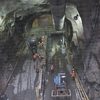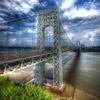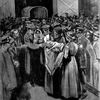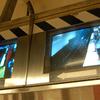Jim O'Grady appears in the following:
MTA Chief: 'Yes' To Extending 7 Train Extension, 'No' to Free Ferry Transfers
Friday, April 27, 2012

MTA chairman Joe Lhota told planners at a Midtown conference on Friday that the first project on his "wish list" is extending 7 train down 11th Ave to 23rd St.
NY MTA Chief Lhota: 'Yes' To Extending 7 Train Extension, 'No' To Free Ferry Transfers
Friday, April 27, 2012
Construction proceeds on the 7 subway train extension under the Far West Side of Manhattan. (NY MTA photo)
(New York, NY - WNYC) NY Metropolitan Transportation Authority chairman Joe Lhota told planners at a Midtown conference that the first project on his "wish list" is extending the Number 7 subway train down 11th Avenue to 23rd Street.
"It's something that I think would make sense because if you look at the demographics of the West Side, we shouldn't just make one stop," he told reporters after taking part in a workshop at the Regional Plan Association's annual assembly, which was held at the Waldorf-Astoria Hotel.
Lhota said, "It's important to have plans, to have a wish list." But he cautioned there was no active push to send the 7 train from Times Square past its planned terminus at W 34th Street. "I'm not sure it can be done," he said. "I'm not sure about how close you can get to the Hudson River."
The $2.1 billion extension is scheduled to be done by December 2013 at a cost of $2.1 billion. It's being built in conjunction with a massive development of the Hudson Yards immediately to the south.
NYC Mayor Michael Bloomberg has also been thinking about boosting the capacity of New York's transportation system.
Appearing Friday as a guest on WOR Radio's John Gambling Show, he said "it'd be great" to offer free transfers to the city's private ferries with a Metrocard. "It's all one big thing in these days of technology," the mayor said. "You could use one card and then revenue could be divided up" between the ferry operators and the NY MTA.
Lhota liked the idea of allowing ferry passengers to pay by Metrocard, noting that several non-NY MTA transit operators in the region already do that, from the PATH Train to New Jersey and a newly privatized bus system on Long Island. But he wasn't keen on the idea of making the transfer free and sharing fares. "The NY MTA is in no position to share its revenue with the ferries," he said.
The NY MTA is perennially cash-strapped and only recently received funding from the state for the last three years of a five-year capital plan.
I Think That I Shall Never See A Poem As Lovely As That One, Over There, By Mayor B
Thursday, April 26, 2012
It could not be determined by press time whether this was Ovid or Michael Bloomberg.
(New York, NY -WNYC) UPDATED Question: Which of these names does not belong with the others? Dante, Ovid, Michael Bloomberg, William Butler Yeats?
Answer: Trick question. Each of those poets will have their work displayed on a large Times Square video screen Thursday as part of Poem in Your Pocket Day.
Before the the Mayor's Office released poet Bloomberg's verse, we imagined some. (Actual poem at end of post.)
For example, this Bloombergian haiku:
New York needs further
remaking. On that, I’m firm.
Therefore, my third term.
New York has celebrated Poem in Your Pocket Day since 1992. But this appears to be the first year that the mayor's metric prosody will be beamed onto MTV's video screen at 44th Street and Broadway, beginning at 10 a.m.
The Poetry Society of America, which is sponsoring the event, said in a statement that the mayor's "original poem" will share time with "the five winning poetweets of the Mayor’s Office 'Poetweet' contest; images from the MTA Arts for Transit and Poetry Society of America’s newest Poetry in Motion initiative; and poems by famous authors."
Set aside, if you will, the syllabic abomination that is the word "Poetweet" to consider the possibility that Dylan Thomas' defiant line, "Rage, rage against the dying of the light," could be followed by a scrap of mayoral doggerel about the salutary effects of quitting smoking. Perhaps:
I have promises to keep
And besides, a pack of Marlboros isn't cheap.
SUGGESTION: Compose your own fake example of a poem by Mayor Bloomberg and leave it in the comments section below, or "Poetweet" it at us at @TransportNation.
50.5 Million Can’t Be Wrong
By Mike Bloomberg
Hey there, fella! Lady, hey!
Didja hear? It’s “Poem in Your Pocket Day!”
Tenth anniversary – the bubbly’s flowing
People are cheering… yelling… Tebowing
Where best to celebrate this whole affair?
The Crossroads of the World – Times Square
Historic site of many a saga
And on New Year’s Eve… one Gaga
From across the globe, they visit here
50.5 million last year
Wanting to see all they’ve anticipated
Just follow directions – it’s not complicated
Bronx Zoo? (Take the or the )
Rockefeller Center? (Walk 6 blocks, then enter)
Empire State? (Bus to Fifth, then go straight)
Ferry to Staten? (At the tip of Manhattan)
Unisphere in Queens? (Get there via several means)
NY Aquarium? (Too far for kids to walk. Just carry ‘em)
“Mamma Mia”? (Right behind you. See ya.)
So on this big birthday of PIYP
Have a fantastic day in NYC
Take in the town – there is so much here to do!
(Just have a Poem in Your Pocket when you do)
I Think That I Shall Never See A Poem As Lovely As That One, Over There, By Mayor B
Thursday, April 26, 2012

Thursday is "Poem in Your Pocket Day." A number of famous verse can be found in Times Square, which will also mark the debut of poetry by Mayor Michael Bloomberg.
Transport Workers Union Objects To NY MTA Real Estate Deal
Wednesday, April 25, 2012
Rendering of NYU's planned Center for Urban Science and Progress, which would replace the old MTA headquarters in downtown Brooklyn.
(New York, NY - WNYC) The Transport Workers Union Local 100 is criticizing the NY Metropolitan Transportation Authority's decision to take $50 million from New York University to clear out of 370 Jay Street in downtown Brooklyn and make way for a new school of applied science. Union president John Samuelson said the authority should instead renovate the largely empty building and move its offices there from 2 Broadway in Manhattan.
Samuelson spoke during the public comments session of the NY MTA's monthly board meeting. He said the authority could save the $63 million a year it pays in rent to the owners of 2 Broadway, a building the authority renovated ten years ago in a massive boondoggle, by moving its offices into the largely empty Brooklyn building it owns.
"Tens of millions of dollars in rider-generated funds are going to the owners of 2 Broadway every year, which is truly money thrown away," Samuelson said.
He suggested that money spent on rent could be applied to reverse the $53 million a year in service cuts enacted by the NY MTA in 2010 as a cost-saving measure.
The 14-story building at 370 Jay Street has sat largely empty since the New York City Transit Authority moved its offices into Manhattan. Since then, the NY MTA has been paying the city a dollar a year to hold onto the property because its 14th floor holds telecommunications equipment the authority needs to run the subway. The NY MTA will use some of the money it gets from the NYU deal to move that equipment into the Jay Street-Metrotech subway station below the building.
An NY MTA spokesman dismissed Samuelson's criticisms, saying 370 Jay Street wouldn't provide enough office space and would cost $186 million to fix up and move into. "Shifting folks from 2 Broadway to 370 Jay Street would not be an economic benefit," he said.
Union Objects To MTA's Departure From 370 Jay Street
Wednesday, April 25, 2012

The Transport Workers Union is criticizing the MTA's decision to take $50 million from NYU to clear out of 370 Jay Street in downtown Brooklyn and make way for a new school of applied science. Union President John Samuelson said the authority should instead renovate the largely empty building and move its offices there from 2 Broadway in Manhattan.
Traffic Down But Revenues Soar After Toll Hike At NY-NJ Port Authority Crossings
Monday, April 23, 2012

Six months after the Port Authority of New York and New Jersey raised prices at its six bridges and tunnels, the numbers are in: about a half million fewer drivers per month are using them. That's a 5 percent decrease overall.
Traffic Is Down But Revenues Soar In Six Months After Toll Hike At NY-NJ Port Authority Crossings
Sunday, April 22, 2012
The George Washington Bridge The George Washington Bridge is a NY-NJ Port Authority crossing that links New Jersey to Manhattan. (Flckr / Ciorra Photogrpahy)
(New York, NY - WNYC) Six months after the Port Authority of New York and New Jersey raised prices at its six bridges and tunnels, the numbers are in: about a half million fewer drivers per month are using them. That's a 5 percent decrease.
The drop in vehicle usage is to be expected, especially given that four months after prices went up at the crossings, tolls jumped by 50 percent on the New Jersey Turnpike and Garden State Parkway. Those are feeder roads to the Port Authority crossings, which laid a double toll hike whammy on drivers making a typical trip to Manhattan or Staten Island.
Traffic has fluctuated in the past six months but has remained consistently down. In the 16 months before the toll hikes, the number of vehicles using authority crossings ranged from 10 million to 11 million--excluding three months of extreme weather during late 201o and early 2011. Then came September, when the authority raised peak-time E-ZPass tolls to $9.50 from $8. (After scheduled increases through 2015, that toll will be $12.50.) Since then, usage of the crossings has ranged from 9 to 10 million vehicles per month.
The hikes remain contentious. A February audit of the authority, conducted as a condition of support for the toll hikes by New Jersey Governor Christie and New York Governor Cuomo, found a $4 billion cost over-run at the World Trade Center and an average salary for authority employees of $143,000 per year. Both governors used the audit as an occasion to blast the authority for wasteful spending.
New Jersey Senator Frank Lautenberg held a Congressional hearing on Wednesday to grill Bill Baroni, Deputy Executive Director of the Port Authority of New York and New Jersey, about the fairness of the hikes. The hearing devolved into political theater as Baroni, a Christie appointee, told Lautenberg he was unfit to investigate the impact of the toll hikes because the senator had for five years used the bridges and tunnels for free, a perk of his position as a Port Authority commissioner.
No Quick Fix for SI Ferries Crippled by Chronic Engine Trouble
Friday, April 20, 2012

The Staten Island Ferry is free to passengers, but engine problems with three of the fleet’s seven boats are costing the city millions. And that’s causing a showdown between the city Department of Transportation and Comptroller John Liu.
Almost Half Of Staten Island Ferry Fleet Crippled By Chronic Engine Trouble
Friday, April 20, 2012
Staten Island Ferry looking iconic as it crosses New York harbor. (Photo by shiny red type)
(New York, NY - WNYC) The Staten Island Ferry is free to passengers, but engine problems with three of the fleet's seven boats are costing the city millions. And that's causing a showdown between the city Department of Transportation and NYC Comptroller John Liu.
DOT says the ferry's three largest boats, which cost $139 million, have had problems with their propulsion systems since they went into service in 2005 and 2006. The department says the original contractor, the Wisonsin-based Manitowoc Marine Corporation, has failed repeatedly to fix them. So the department has asked Liu to approve an emergency contract of $9.5 million to hire Siemens to do the job.
DOT Spokesman Scott Gastel said in a statement to TN that, “This vendor will be a one stop shop for an integrated propulsion system on all three boats, an upgrade that will benefit over 65,000 passengers who rely on the Ferry each day. We clearly explained to the Comptroller why the new Siemens products are needed.”
Liu is not pleased. He said, "It's appalling that the highly-touted new ferry boats are still saddled with defects and more troubling that the DOT has no clear solution for resolving these longstanding problems.”
The comptroller is only approving $3.2 million for repair work on one of the ferries, which is in dry dock in Virginia. He says if that goes well, he might approve more. In the meantime, ferry riders must make do with boats have trouble getting up to speed.
100 Years Ago, Arrival of Ship Carrying Titanic Survivors Set Off Media Frenzy in NYC
Tuesday, April 17, 2012
Popular illustration, titled "Arrival of the Ship of Sorrows," shows Titanic survivors disembarking in New York.
(New York, NY - WNYC) The sinking of the Titanic on April 15 in 1912 was the biggest news story of its day. But people on land had only the barest facts about the tragedy at sea until almost three days later, when more than 700 survivors reached New York on the steamer Carpathia. What followed was an unprecedented media frenzy.
The Carpathia had wireless communication with the shore but on its way to New York had sent only a trickle of news. After a couple of days, it was known that most of the passengers and crew on the Titanic had died — but not much beyond that.
A theory for the near-news blackout is that the White Star Line, which owned the Titanic, was trying to manage the story by shutting out the media.
For example, newspaperman Carlos Hurd, who worked for a Hearst paper in St. Louis, happened to be on the Carpathia. Hearst editors in New York sent frantic messages to him begging for news but the ship's crew intercepted them.
That left the public was frothing for details of the disaster. By the time the Carpathia arrived in the New York harbor on April 18 around 9:15 P.M., thousands of people were standing outside Pier 54 at West 13th Street on the Hudson River.
Many were family members of passengers who didn't know if their relatives were dead or alive. Reporters waded in and worked the crowd, interviewing relatives while waiting to catch survivors coming off the ship and record their memories while they were still visceral.
Meanwhile, out in the harbor, more than 50 tugboats jammed with journalists met the Carpathia in lower New York harbor. Reporters with megaphones yelled up at the ship, offering $50 or $100 for eyewitness accounts. Photographers' cameras lit up the side of the ship with flashes of magnesium powder.
This was before the rise of radio and movie reels, when newspapers ruled. It was also a Darwinian moment in the history of American journalism.
Mitchell Stephens, professor of journalism at NYU and author of The History of the News, says there were dozens of papers in multiple languages coming out three times a day in New York, with 'Extra' editions. "It was cutthroat competition between these newspapers for stories and to be first on the streets with stories,” he said. “So the streets were full of newspapers being hawked all day long."
Stephens added that the U.S. also had the highest per capita newspaper circulation in the world in the early 20th century. The fight was on to feed that audience. "Races for news were nothing new and packs of journalists were already starting to develop," he said.
Two of the heavyweights in the city were William Randolph Hearst's New York Journal and the up-and-coming New York Times.
Carr Van Anda was the editor of The Times in 1912. He rented out the top floor of the Strand Hotel, now called the Liberty Inn, and set up a temporary newsroom to better cover the disaster. The hotel was just a block from Pier 54. Then Van Anda set his sites on interviewing the Titanic’s 22-year-old wireless operator, Harold Bride. He even paid Bride’s employer, Guglielmo Marconi, who was the inventor of the wireless, to make sure he got an exclusive interview.
Marconi sent a message to Bride on the Carpathia that read, “Stop. Say nothing. Hold your story for dollars in four figures.”
When Harold Bride got to New York, a Times reporter met him onboard and took down his istory. He then reported what he'd heard: that the band played on while the ship went down and that a stoker had broken into the wireless room and tried to steal Bride's lifejacket as the Titanic was sinking, forcing the operator to beat the stoker senseless.
As for Hearst man Carlos Hurd, he spent his trip on the Carpathia interviewing Titanic survivors and hiding his notes from the crew.
He wrote up his stories and put them in a cigar box rigged with Champagne corks as floats. When the ship reached the harbor, Hurd spotted a Hearst editor in a tugboat and hurled the cigar box into the water. The editor fished it out and rushed it back to the newsroom in Lower Manhttan. Before the Carpathia had docked, an 'Extra' edition of The New York World was on the street with the banner headline:
"Titanic Boilers Blew Up, Breaking Her In Two After Striking Berg."
Not quite as fast as the Internet, but fast. And accurate. And heartbreaking.
100 Years Ago, Arrival Of Titanic Survivors In NYC Set Off Media Free-For-All
Sunday, April 15, 2012

The sinking of the Titanic on April 15 in 1912 was the biggest news story of its day. But people on land had only the barest facts about the tragedy at sea until almost three days later, when more than 700 survivors reached New York on the steamer Carpathia. What followed was an unprecedented media frenzy.
On Opening Day, NY Yankees Parking Garages Limp Toward Default
Thursday, April 12, 2012
Yankee parking garage that was closed due to lack of customers. (Photo by Jim O'Grady)
The Yankees hold their first home game in the Bronx on Friday afternoon, but the company that owns their stadium's parking garages may be on its last legs.
The Bronx Parking Development Corporation is struggling to make payments on the $237 million in tax exempt bonds used to build the garages, placing the company in danger of default
As TN reported, the eleven garages were a little more than one-third full on game days last year. On days without a game, an average of 70 people paid to park there, leaving nearly 9,000 spaces empty. Each space costs $35 or $48 for valet parking. Smaller garages in the neighborhood charge much less.
Late last month, the corporation said it needed to raid its cash reserves to make its latest payment on its bond obligations. In a letter to bond holders, the corporation said that if it didn't do that, it would immediately default. The same crisis occurred before the last bi-annual payment came due, in November.
The parking company, which was set up with the backing of the Bloomberg administration because the Yankees wanted more parking spaces, also owes $25 million to the city in rent and property taxes.
In an audit last month, New York City Comptroller John Liu blasted the city Industrial Development Agency for recommending in 2006 that the bonds be issued to finance the new garages. "NYIDA did not independently analyze the financial position and cash flow of the proposed parking operation or the parking needs of the community to determine if there would be a demand for increased parking, at higher prices, in the Yankee Stadium vicinity," the report said.
Critics like Bettina Damiani of Good Jobs New York agreed with Liu's assessment. "This project was forced through despite the screaming concerns of local residents, transportation experts and good government advocates," she said.
The agency replied in a written statement that it relied on the recommendation of "a nationally recognized expert" in giving a thumbs up to the deal, and then helping to arrange for its tax exempt financing.
Agency spokesman Kyle Sklerov also stressed in an email to WNYC that the city would not lose money if the Bronx Parking Development Corporation defaulted on its debt. “The bonds are not a general obligation of the City or the IDA in any way, shape or form," he said.
Damiani said that may be true, but the garages going bust would mean a big hit to the reputation of the agency. "What does it mean for future projects in this city when a development as prominent as the one associated with Yankee Stadium goes into default?" she asked.
Sklerov disagreed. He said, "We expect that bond investors will continue to evaluate future IDA projects on their own merits.”
The garages were also controversial because city parkland was paved to make way for some of them. That parkland was fully replaced only last week when, after five years, three new baseball diamonds on the site of the old Yankee Stadium were opened to the public.
A call to the Bronx Parking Development Corporation was not returned.
On Opening Day, Yankee Parking Garages Limp Toward Possible Default
Thursday, April 12, 2012

The Yankees hold their first home game in the Bronx on Friday afternoon, but the company that owns their stadium's parking garages may be on its last legs.
NJ Gov Christie on ARC Tunnel: Believe Me, Not The "Bureaucrats in Washington, DC"
Wednesday, April 11, 2012
NJ Gov. Chris Christie spoke about the ARC Tunnel at a press conference in Bridgewater. (Photo by Sharyn Jackson/WNYC)
(New York, NY - WNYC) New Jersey Governor Chris Christie doubled down today in his fight with Congressional investigators over whether he used faulty numbers to justify killing the ARC tunnel.
As readers of TN know, ARC is an acronym for Access to the Region's Core, a commuter rail project that would have brought more trains between Manhattan and New Jersey--a crowded and increasingly popular corridor that is nearly at capacity.
Christie claimed the trans-Hudson tunnel was on track to cost $14 billion, with overruns borne by New Jersey taxpayers. But a new report from the Government Accountability Office says the price tag was more likely to have been $10 billion and that the state would have paid only 14.4 percent of that.
The issue is important because Christie rode it, in part, to make a name for himself as a politician who dared hold the line against government spending, which in turn thrust him into the ranks of Republicans who are considered viable presidential candidates. Following is a transcript of the governor's remarks on ARC and the GAO report from a press conference this morning; you can also listen to his comments below.
So the fact of the matter is that--and the last thing by the way that the report doesn't understand is what you understand about the way it works with the Port Authority. This was considered a New Jersey project in the Port Authority and you know that there has to be parity between New Jersey and New York spending. So every dollar we spent on cost overruns, either from the state of New Jersey or if you did it from the Port Authority, would come out of other Port Authority money that would go to other New Jersey projects. That cost New Jersey. So it's absolutely appropriate for us to say that that's a New Jersey cost, because that money would otherwise be available for other New Jersey projects. So here's the bottom line, Michael. First is I don't think anybody in New Jersey needs advice from Congress about how to spend money. We see what a mess they're in down there. And I think the people of New Jersey are comfortable with the fact that I made the evaluation we couldn't afford this and cancelled it as a result. Secondly, the implication that somehow I should have let this project go forward and left it to later because they would have worked something out with us on the cost overruns? That's akin to like, I'm here from Washington and I'm here to help, you know. I was not putting New Jersey tax payers at that risk.
So let's everybody really read the GAO report and let's look at the commentary this morning from the person at the GAO who said this morning in the newspaper that the report does not opine on the accuracy of any of the numbers.
So, let's stop... I'm happy to be criticized -- happy to be criticized -- by Sen. Frank Lautenberg and the New York Times. I take that as a badge of honor. Actually it means I'm doing something right for the taxpayers in this state...
(another question, inaudible)
That's because they don't understand the Port Authority parity issue. That's New Jersey money, paid by New Jersey tollpayers. That expect it to go to New Jersey projects. And every nickel of cost overruns that would go to that contribute to a greater contribution by New Jersey. Michael, look at our reporters notes from yesterday, we go through this in great specificity and what it shows from the real numbers is, that the cost to New Jersey was anywhere between 72 and 78 percent. And so this is just a basic misunderstanding by bureaucrats in Washington DC who don't understand how the Port Authority works. They say the Port Authority is not New Jersey money. Well it sure as hell is New Jersey money. And it's money that wouldn't be available to work on the Goethals Bridge. It's money that wouldn't be available to work on the Bayonne Bridge. It's money that wouldn't be available to rebuild the Lincoln Tunnel helix. These are all New Jersey projects. And that we would not get the money otherwise. So they misunderstand it...
I urge you all to look at it and to stop reading the New York Times as your primary source for information on this. It was a leaked report, spun by partisans to the New York Times. And if you read the report they do not once say that we exaggerated the numbers. They don't once give an opinion as to which numbers were right. One thing they do point out in there, is three times in five months, the FTA changed the numbers. You want me to rely upon the FTA estimate when they changed them three times in five months? What that shows me is they had no idea what this project was going to cost, and that's what I was saying. We had no way of knowing how much this was gonna cost, but the one thing the GAO report does confirm? New Jersey was on the hook for every dollar of the cost overruns. And the only thing they can say is, well, the federal government may have helped in the end. Yeah, you know, that's like, I'd be happy to pay you tomorrow for a hamburger today. Sorry, I'm not letting the New Jersey taxpayers be exposed in that way.
After 5-Year Wait, Ballfields Near Yankee Stadium Finally Open
Monday, April 09, 2012
MaCombs Dam Field sits in the shadow of Yankee Stadium. (Photo by Jessie Wright-Mendoza)
(New York, NY - WNYC) It's been a long wait for a South Bronx neighborhood that heard promise after promise about how parkland that became parking garages would one day be replaced. That day is now here.
Five years after the city of New York allowed a heavily used set of baseball diamonds to be paved over for a parking lot serving the new Yankee Stadium, a set of replacement fields has opened--a year behind schedule. In the meantime, those garages have remained mostly empty on Yankee game days and, as TN has reported, the company that owns them is on the verge of default.
The field, which was also known as Heritage Field and is actually a set of three fields, saw its first action last week with a game between Cardinal Hayes and All Hallows high school varsity baseball teams. For years, the teams have been playing "home" games on opponents' fields while waiting for the new fields to open.
Neighborhood residents had to wait until Saturday to get their first access to the 10.8 acres of Kentucky bluegrass, installed where the old Yankee Stadium once stood. Standing outside the new Heritage Field, South Bronx resident Carlos Juarez said his neighbors have gone through a range of emotions as they waited for the former parkland to be replaced.
"In the beginning, people refused to support this construction," he said. "They took down the old Yankee Stadium and people were like, 'What are they going to do?' But when they saw the result, they just loved it."
Similarly, Parks Commissioner Adrian Benepe stressed the end result rather than the lengthy and sometimes rancorous process that delivered it.
"When you talk to people in the neighborhood about the old MaCombs Dam Park, they knew they were not particularly great," Benepe said. "The old MaCombs Dam ballfield was sort of in a pit surrounded by elevated roadways."
The new MaCombs Dam Field will be open from 10 a.m. to dusk and will give priority to teams with permits from the city. But when those teams aren't playing, the public will be free to step on turf where Babe Ruth and Joe DiMaggio once plied their trade. Blue polymer fiber stitched into the sod marks where home plate once stood. Anyone can straddle it and, in their minds eye, knock a long ball out of the park.
After 5-Year Wait, Ballfields Near Yankee Stadium Finally Set to Open
Friday, April 06, 2012

The gates were locked on Friday at MaCombs Dam Field alongside the new Yankee Stadium. That's despite reports the field had opened this week, a year behind schedule and five years after a set of neighborhood baseball diamonds were paved over to make way for a stadium parking lot.
Post 9/11 Security Upgrade To NYC Transit Lags
Wednesday, April 04, 2012
(New York, NY - WNYC) A new report says the first phase of the NY MTA's security upgrade after 9/11 won't be done for another two years, and that the cost keeps rising.
NY State comptroller Thomas DiNapoli says more than 3,000 cameras are already in place at transit hubs and in bridges and tunnels. What's missing is the authority's ability to monitor some of them, and to communicate efficiently with the police and fire departments. Another problem is communications rooms in the subway have been prone to overheat.
The work was supposed to be done in 2008 but a new report by the comptroller is pushing that date back to 2014. (Only last year, the comptroller said Phase 1 would be finished this year.) The final budget is expected to be $882 million dollars--nearly $300 million more than originally estimated.
It's costing more than expected to get seven command centers up and running. And the price could rise another $150 million if the NY MTA loses a court fight with Lockheed Martin, the project's original contractor. The authority says the company reneged on its contract; Lockheed Martin says the NY MTA didn't give it enough access to tunnels and other locations to get the work done.
The NY MTA says steady progress on its security upgrade has been made and that they've finished reinforcing 17 bridges, tunnels and train stations against terrorist explosions.
"We agree with the Comptroller's assessment that the system is more secure and the public better protected as a result of the security investments that we have made," said MTA spokesman Aaron Donovan. "The report's conclusion is that the biggest obstacle going forward is funding, and we don't disagree."
Post 9/11 Security Upgrade to NYC Transit Lags
Wednesday, April 04, 2012

A new report says the first phase of the NY MTA’s security upgrade after 9/11 won’t be done for another two years, and that cost keeps rising.
BREAKING: NY MTA Head Says 7 Train to NJ "Not Going To Happen In Our Lifetime"
Tuesday, April 03, 2012
(photo by 12th Street David via flickr)
MTA chairman Joe Lhota says a proposed extension of the 7 train subway line from Manhattan to New Jersey is "not going to happen in our lifetime. It's not going to happen in anybody's lifetime."
Lhota said "the expense is beyond anything we're doing," adding that building railyards in New Jersey would be costly.
Lhota was speaking Tuesday morning at a breakfast meeting of the New York Building Congress at the Hilton Hotel in Midtown Manhattan.
He was asked about a trans-Hudson rail connection and what might fill the gap of the ARC Tunnel, a project killed by New Jersey Governor Chris Christie in late 2010. Lhota said he favors Amtrak's proposed Gateway Tunnel project, which would bring Northeast Corridor trains from New Jersey through a tunnel under the river to an expanded Penn Station. "I think it's really important to support that," he said.
The impetus for a 7 train extension comes from New York City Mayor Michael Bloomberg, who proposed the project last year.
"I've told the mayor this, I can't see that happening in our lifetime," Lhota said.
Within hours of Lhota's comments, speaking at his own press event, Mayor Bloomberg said he understood funding was an issue, but that he hoped the 7 extension "happens in somebody's lifetime."
"I have great respect for Joe Lhota and he' s a realist," the Mayor added. "I don't know, we can keep trying. It would be great if it happened. Having more tunnels over to New Jersey will help both New Jersey and New York City. If people can go back and forth and it would clean the air because there would be less traffic jams on the tunnels and bridges. Getting a ways to have people come in and out of the city with mass transit is obviously the way to go. I'm sure what Joe is referring to is its very hard to see the funding for that come right now--if someone could provide the funding, I can tell you Joe Lhota could build it.".
Lhota said that he understood the project's appeal to some riders. "Of course New Jersey would like to have it because they think they can get across the Hudson for $2.25."
But then he reiterated his assessment of a subway to Secaucus: "Not a chance."



















